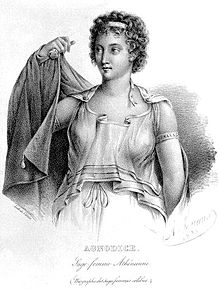Although some research suggests that Agnodice might have been a mythical figure, there’s no denying her influence on women in medicine, both modern and ancient. Born in the 4th Century BCE, she was the first female doctor from Athens. Her drive to become a doctor stemmed from the growing number of women who suffered from painful or fatal childbirth. However, it was illegal at the time for women to become doctors, so Agnodice disguised herself as a man in order to study medicine.
After qualifying as a doctor, Agnodice continued to disguise herself so she could treat the women of Athens. However, one woman in labor was modest and would not allow a male physician to treat her, so Agnodice exposed herself to the woman to prove her gender. The rumors of a female physician spread, and the women of Athens began to seek her out. However, male physicians, angered at losing patients, accused her of seducing her patients. Agnodice again revealed her true gender to the men condemning her, who then accused her of deceit, as well as breaking the law banning women from practicing medicine. Though this crime carried a death sentence, crowds of women rushed to her defense (and chastised their husbands). Agnodice was acquitted, and the law was changed to allow women to be treated by female physicians.
For centuries, women have used the story of Agnodice to defend themselves in the often male-dominated profession of medicine. As there are no contemporary accounts of Agnodice, it is thought that her story may be a parable used to help the Ancient Greeks understand the need for female physicians, and modern women still find her struggles inspiring.
For more on Agnodice, watch Professor Helen King’s interview on Classics Confidential.


She’s definitely not real – the story has every hint of coming from an ancient Greek novel. But you are so right about her importance as a symbol later on. I’ve written a lot about her – http://www.wondersandmarvels.com/2015/01/agnodice-down-and-dirty.html – is one example, and I did a little podcast that you may find fun, https://www.youtube.com/watch?v=IkMILds1Gg4
Hi, Helen,
My research suggests that Agnodice was very probably mythical; amongst other things, the Greeks liked naming characters based on their virtues, and I find it unlikely that she would just happen to have a name that translates to “chaste before justice,” given that she supposedly had to prove her chastity for justice. Additionally, the “woman dressed as man” trope is common in fiction‚Äìand not just Shakespeare!‚Äìbut not so easy to pull off in reality. Still, her story highlighted the importance and necessity for female physicians (even if they could only treat other women).
Thanks so much for the links to your article and video! Would it be ok if we included the video in the post above?
-Katie
Social Media Manager
Happy for you to do thwt, Katie!